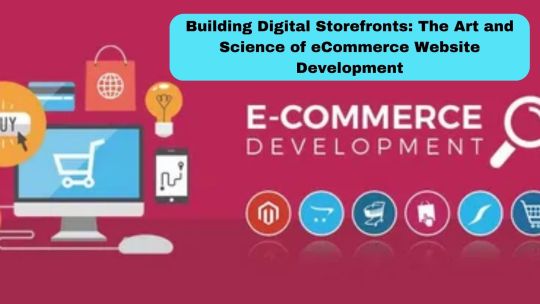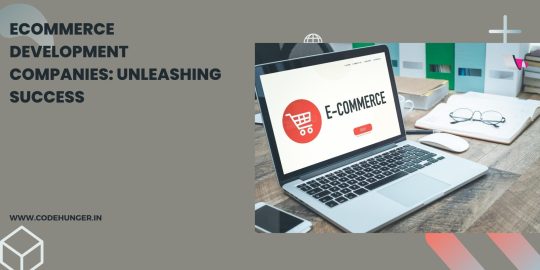#Digital Storefront
Explore tagged Tumblr posts
Text
Building Digital Storefronts: The Art and Science of eCommerce Website Development
In today’s digital age, shopping has evolved from a physical experience to a virtual one. Consumers no longer need to visit brick-and-mortar stores to purchase their favorite products. Instead, they turn to eCommerce platforms for a seamless, convenient shopping experience. Behind every successful online store lies a well-designed, functional website—crafted through a process known as eCommerce website development. This process is crucial for businesses seeking to establish a competitive edge and connect with a global customer base.

What is eCommerce Website Development?
At its core, eCommerce website development refers to the process of designing, building, and maintaining an online store. It involves more than just creating a visually appealing website—it’s about delivering a smooth and secure shopping experience. This process includes everything from setting up product pages and integrating payment gateways to ensuring site security and optimizing for search engines.
Businesses need an intuitive and user-friendly platform to attract customers and encourage repeat purchases. A well-crafted eCommerce website is more than just a digital storefront—it’s a tool to grow brand visibility, increase sales, and foster customer loyalty.
Key Components of a Successful eCommerce Website
To build a successful eCommerce website development platform, several essential components must come together to create a cohesive, user-friendly experience. These elements are critical in ensuring the website meets customer needs while supporting business goals.
1. User-Centric Design
The design of an eCommerce website must prioritize the user experience (UX). A clean, intuitive layout with easy navigation encourages visitors to explore and complete purchases. Responsive design is also essential—customers should enjoy a seamless shopping experience whether they’re using a smartphone, tablet, or desktop computer.
2. Secure Payment Integration
One of the most important aspects of eCommerce is the ability to accept payments securely. Integrating reliable payment gateways, such as PayPal, Stripe, or credit card processors, is essential. Secure Socket Layer (SSL) certificates and data encryption further protect customer information and build trust.
3. Product Management System
An effective product management system allows businesses to easily add, update, and organize products. This includes creating detailed product descriptions, adding high-quality images, setting prices, and managing inventory. Categories and filters enhance the shopping experience by allowing customers to find products quickly.
4. Search Engine Optimization (SEO)
For an eCommerce site to attract organic traffic, it must be optimized for search engines. This includes optimizing product pages with relevant keywords, improving page load speed, and ensuring the site is mobile-friendly. SEO helps improve visibility on search engines like Google, driving potential customers to the store.
5. Customer Support and Communication
Providing accessible customer support is vital for building trust and ensuring customer satisfaction. Features such as live chat, contact forms, and detailed FAQs allow businesses to address customer concerns promptly. Automated email systems can also provide order confirmations, shipping updates, and personalized marketing messages.
6. Analytics and Reporting Tools
Tracking customer behavior and sales performance is essential for growth. eCommerce websites should integrate analytics tools to monitor key metrics such as conversion rates, average order value, and traffic sources. This data provides valuable insights into customer preferences and helps refine marketing strategies.
Why Invest in eCommerce Website Development?
The rise of online shopping has transformed how businesses operate. Investing in eCommerce website development is no longer optional—it’s a necessity for staying competitive and meeting customer expectations. Here are a few reasons why businesses should prioritize developing a robust eCommerce platform:
1. Reach a Global Audience
An online store allows businesses to expand beyond local markets and reach customers worldwide. With the right marketing and logistics, companies can sell products across borders and tap into new customer bases.
2. 24/7 Availability
Unlike physical stores with limited operating hours, an eCommerce website is open around the clock. Customers can browse and make purchases at any time, increasing the potential for sales and revenue generation.
3. Cost Efficiency
Operating an online store is often more cost-effective than maintaining a physical location. Businesses save on rent, utilities, and staffing while still reaching a large audience. Additionally, digital marketing strategies can be more affordable and measurable compared to traditional advertising methods.
4. Personalized Shopping Experiences
Through data analytics and customer tracking, businesses can offer personalized experiences. From recommending products based on browsing history to sending targeted promotions, personalization enhances customer satisfaction and loyalty.
5. Scalability and Flexibility
An eCommerce website can grow alongside the business. Whether adding new products, expanding into new markets, or offering seasonal promotions, the platform can be scaled and customized to meet evolving business needs.
Choosing the Right eCommerce Platform
When building an eCommerce website, selecting the right platform is a crucial decision. Different platforms offer unique features and capabilities. Popular options include:
Shopify: User-friendly with a variety of templates and integrated payment options.
WooCommerce: A flexible WordPress plugin ideal for businesses seeking customization.
Magento: A robust solution suitable for large-scale businesses with advanced needs.
BigCommerce: Scalable and feature-rich for growing businesses.
When choosing a platform, consider factors such as ease of use, customization capabilities, payment options, and future scalability.
Best Practices for eCommerce Website Development
To ensure a successful eCommerce site, follow these best practices:
Prioritize User Experience: Ensure a smooth, intuitive shopping experience with easy navigation.
Optimize for Mobile: Implement a responsive design to cater to mobile users.
Enhance Security: Use secure payment gateways and SSL encryption to protect customer data.
Speed Matters: Optimize page load times to prevent customer drop-offs.
Regular Updates: Keep content fresh by updating product listings and optimizing for SEO.
Conclusion
In a world where online shopping is the norm, eCommerce website development plays a pivotal role in business success. A well-designed, user-friendly platform enables businesses to reach new markets, increase sales, and provide customers with a seamless shopping experience. By investing in the right tools, technology, and strategies, companies can create a digital storefront that not only meets today’s demands but also adapts to future growth.
Whether you’re a startup looking to launch your first store or an established brand aiming to enhance your online presence, investing in eCommerce website development is a vital step toward long-term success in the digital marketplace.
Name : Website Development Company Phone no : 97143632600 Address : Office №3, 29th floor, Al Saqr Business Tower, Sheikh Zayed Road, Dubai. (Prontosys IT Services) Website : https //websitedevelopmentcompany.ae/ Facebook: https://www.facebook.com/websitedevelopmentcompanydubai Email : [email protected] Instagram: https://www.instagram.com/website_developmentcompany/
0 notes
Text
Essential Guide to Developing an eCommerce Store for Startups
Launching a new business is an exciting journey, and creating an eCommerce store is a powerful way to get your brand out there. A well-built online store displays your products and helps potential customers find and connect with you. Here’s a quick guide to eCommerce store development to get your startup on track and ready to grow online.
Why an eCommerce Store Is a Must for Startups
Building an online presence early on can set your business up for long-term success. Here are some top reasons to launch an eCommerce store:
Reduced Operational Costs: Setting up an online store costs less than a physical shop, making it ideal for startups on a budget.
Reach More Customers: An eCommerce store opens your business to a worldwide audience, letting you reach potential buyers far beyond your local area.
Sales Around the Clock: With an online store, customers can shop at any time, boosting convenience and increasing your chances of making a sale.
Actionable Insights: An eCommerce platform provides valuable data about customer preferences and behavior, helping you optimize your offerings and marketing.
Steps to Building an Effective eCommerce Store
Creating an eCommerce store takes some planning. Here’s a look at the essential steps to get started:
Define Your Brand and Audience: Before diving in, clarify what your brand stands for and who your ideal customer is. This foundation will guide your website’s design, tone, and content.
Select the Right eCommerce Platform: Different platforms offer unique advantages. Options like Shopify, WooCommerce, and BigCommerce are popular because they cater to different needs, from ease of use to advanced customization.
Design with the User in Mind: Your website should be clean, attractive, and simple to navigate. A user-friendly design keeps visitors engaged and increases the chance of conversion.
Offer Secure Payment Options: Customers need to know their payments are safe. Make sure you provide secure gateways and an SSL certificate to protect their data.
Optimize for Search Engines: Search engine optimization (SEO) can help your site rank higher in search results, driving organic traffic to your store. Focus on keywords, easy-to-read URLs, and optimized product descriptions.
Plan for Scalability: As your business grows, so should your website. Building your site with scalability in mind helps it handle more visitors, products, and features as you expand.
How Much Will It Cost?
The cost of developing an eCommerce store varies based on complexity, features, and customization. Here’s a general idea of what you might spend:
Basic Store: $1,000 - $5,000
Great for startups needing a simple design with a basic product catalog and checkout.
Mid-Range Store: $5,000 - $15,000
Includes custom design, product filtering, multiple payment options, and optimized SEO.
Advanced Store: $15,000 and up
Suited for larger operations, offering advanced features like personalization, product recommendations, and integrated marketing tools.
Top eCommerce Service Providers for Startups
Choosing the right platform and support is crucial for new businesses. Here are some reliable options for eCommerce development:
A-S BPO Solutions LLC – asbposolutions.com: Our team provides personalized eCommerce development with ongoing support to help your startup succeed online.
Shopify – shopify.com: Known for its simplicity and a wide range of templates, Shopify is a good choice for small to medium-sized businesses.
WooCommerce – woocommerce.com: This WordPress plugin offers flexibility and customization, making it popular with businesses that already use WordPress.
BigCommerce – bigcommerce.com: A scalable option that’s robust and ideal for startups with plans for growth.
Squarespace – squarespace.com: Perfect for brands needing visually appealing templates with built-in eCommerce features.
Tips to Maximize Your eCommerce Success
Showcase Products with High-Quality Photos: Clear, well-lit photos can make a big difference in how customers view your products.
Create Detailed Product Descriptions: Avoid generic descriptions; use details that matter to your target audience.
Build a Social Media Following: Social platforms can drive traffic to your store and create a loyal customer base. Focus on networks that resonate with your customers, such as Instagram or LinkedIn.
Encourage Reviews and Feedback: Positive reviews build trust and help attract new customers, so make it easy for customers to share their experiences.
Get Started with A-S BPO Solutions LLC
Building an eCommerce store may seem daunting, but it doesn’t have to be. At A-S BPO Solutions LLC, we offer the expertise you need to bring your startup’s online store to life. Reach out to us at [email protected] or call 213-669-3282, and let’s talk about how we can help you launch and grow your eCommerce business.
#eCommerce development#eCommerce for startups#online store setup#startup eCommerce guide#eCommerce website cost#eCommerce service providers#building an online store#eCommerce store design#small business eCommerce#digital storefront#startup tips#eCommerce tips#online shopping setup
0 notes
Text
Essential Guide to Developing an eCommerce Store for Startups
Launching a new business is an exciting journey, and creating an eCommerce store is a powerful way to get your brand out there. A well-built online store displays your products and helps potential customers find and connect with you. Here’s a quick guide to eCommerce store development to get your startup on track and ready to grow online.
Why an eCommerce Store Is a Must for Startups
Building an online presence early on can set your business up for long-term success. Here are some top reasons to launch an eCommerce store:
Reduced Operational Costs: Setting up an online store costs less than a physical shop, making it ideal for startups on a budget.
Reach More Customers: An eCommerce store opens your business to a worldwide audience, letting you reach potential buyers far beyond your local area.
Sales Around the Clock: With an online store, customers can shop at any time, boosting convenience and increasing your chances of making a sale.
Actionable Insights: An eCommerce platform provides valuable data about customer preferences and behavior, helping you optimize your offerings and marketing.
Steps to Building an Effective eCommerce Store
Creating an eCommerce store takes some planning. Here’s a look at the essential steps to get started:
Define Your Brand and Audience: Before diving in, clarify what your brand stands for and who your ideal customer is. This foundation will guide your website’s design, tone, and content.
Select the Right eCommerce Platform: Different platforms offer unique advantages. Options like Shopify, WooCommerce, and BigCommerce are popular because they cater to different needs, from ease of use to advanced customization.
Design with the User in Mind: Your website should be clean, attractive, and simple to navigate. A user-friendly design keeps visitors engaged and increases the chance of conversion.
Offer Secure Payment Options: Customers need to know their payments are safe. Make sure you provide secure gateways and an SSL certificate to protect their data.
Optimize for Search Engines: Search engine optimization (SEO) can help your site rank higher in search results, driving organic traffic to your store. Focus on keywords, easy-to-read URLs, and optimized product descriptions.
Plan for Scalability: As your business grows, so should your website. Building your site with scalability in mind helps it handle more visitors, products, and features as you expand.
How Much Will It Cost?
The cost of developing an eCommerce store varies based on complexity, features, and customization. Here’s a general idea of what you might spend:
Basic Store: $1,000 - $5,000
Great for startups needing a simple design with a basic product catalog and checkout.
Mid-Range Store: $5,000 - $15,000
Includes custom design, product filtering, multiple payment options, and optimized SEO.
Advanced Store: $15,000 and up
Suited for larger operations, offering advanced features like personalization, product recommendations, and integrated marketing tools.
Top eCommerce Service Providers for Startups
Choosing the right platform and support is crucial for new businesses. Here are some reliable options for eCommerce development:
A-S BPO Solutions LLC – asbposolutions.com: Our team provides personalized eCommerce development with ongoing support to help your startup succeed online.
Shopify – shopify.com: Known for its simplicity and a wide range of templates, Shopify is a good choice for small to medium-sized businesses.
WooCommerce – woocommerce.com: This WordPress plugin offers flexibility and customization, making it popular with businesses that already use WordPress.
BigCommerce – bigcommerce.com: A scalable option that’s robust and ideal for startups with plans for growth.
Squarespace – squarespace.com: Perfect for brands needing visually appealing templates with built-in eCommerce features.
Tips to Maximize Your eCommerce Success
Showcase Products with High-Quality Photos: Clear, well-lit photos can make a big difference in how customers view your products.
Create Detailed Product Descriptions: Avoid generic descriptions; use details that matter to your target audience.
Build a Social Media Following: Social platforms can drive traffic to your store and create a loyal customer base. Focus on networks that resonate with your customers, such as Instagram or LinkedIn.
Encourage Reviews and Feedback: Positive reviews build trust and help attract new customers, so make it easy for customers to share their experiences.
Get Started with A-S BPO Solutions LLC
Building an eCommerce store may seem daunting, but it doesn’t have to be. At A-S BPO Solutions LLC, we offer the expertise you need to bring your startup’s online store to life. Reach out to us at [email protected] or call 213-669-3282, and let’s talk about how we can help you launch and grow your eCommerce business.
#eCommerce development#eCommerce for startups#online store setup#startup eCommerce guide#eCommerce website cost#eCommerce service providers#building an online store#eCommerce store design#small business eCommerce#digital storefront#startup tips#eCommerce tips#online shopping setup
1 note
·
View note
Text
Unleashing Success: The Power of Ecommerce Development Companies
In the rapidly evolving digital landscape, ecommerce has become the driving force behind countless successful businesses. Behind the seamless online shopping experiences and robust digital storefronts are the unsung heroes – ecommerce development companies. In this blog post, we’ll delve into the pivotal role these companies play in unleashing success for businesses in the digital…

View On WordPress
#Brand Identity Online#Business Growth#Custom Ecommerce#Digital Commerce#Digital Storefront#Ecommerce Development#Ecommerce Features#Ecommerce Maintenance#Ecommerce Platforms#Ecommerce Security#Ecommerce Solutions#Ecommerce Success#Ecommerce Website#Mobile Ecommerce#Online Store Development#Payment Gateways#Scalable Ecommerce#User Experience Design#Web Development Services#Website Customization
0 notes
Text
Transforming Storefronts with LED Displays and Digital Signages

In today's fast-paced world, businesses are constantly seeking innovative ways to attract and engage customers. The traditional storefront, with its static signage, is undergoing a digital revolution, thanks to advancements in LED display technology and digital signages.
Enhanced Visual Appeal
With LED displays, businesses can create eye-catching advertisements, promotions, and dynamic content that draws the attention of passersby.
Dynamic Content
Unlike traditional signage, digital signages offer the advantage of displaying dynamic content. Businesses can easily update and customize their messages to suit changing promotions, seasons, or special events.
Increased Interactivity
Digital signages can also enhance the interactive element of your storefront. Touchscreen displays can provide customers with instant access to product information, and pricing, and even allow them to place orders or make inquiries without the need for a sales representative.
Real-time Updates
Digital signages provide the convenience of real-time updates. Whether it's showcasing the latest offers, displaying customer reviews, or streaming live social media feeds, businesses can keep their content fresh and engaging.
Cost-effective Advertising
In the long run, LED displays and digital signages can be more cost-effective than traditional static signage. While the initial investment may be higher, the ability to change content without the need for physical reprinting or replacement of signs saves on ongoing expenses and reduces waste.
In conclusion, the integration of LED displays and digital signages can transform any storefront into a dynamic and engaging space. The captivating visuals, dynamic content, interactivity, real-time updates, and cost-effective advertising benefits make these technologies essential tools for businesses looking to stand out in today's competitive market. By embracing the digital storefront, businesses can create a lasting impression and drive customer engagement like never before.
0 notes
Text



My first portfolio pieces ;u; practicing time of day!
#im exhausted#this file has over 250 layers#THOUGH IT ONLY TOOK ME 2 DAYS TO COMPLETE ALL 3 IM PROUD OF MYSELF#artist#art#illustration#artists on tumblr#digital art#cute#digital illustration#drawing#painting#japan#japanese#japan travel#japan store#storefront
1K notes
·
View notes
Text

✫・゚*.2009・゚✫*.
#2009#flickr#digital archiving#digitalmemoriez#2000s nostalgia#mall#mallcore#mall nostalgia#childhood memories#childhood nostalgia#image archiving#nostalgic#late 2000s#liminal#liminal spaces#2000s#great american cookies#storefront
76 notes
·
View notes
Text


Coffee Shop Storefront
This time I tried a warm and brighter colour approach, and downloaded some colour palette from Lospec to play with. Comfy52 by bess was used in this piece.



Img.2,3,4 WIP images
#digital art#pixel art#aseprite#pixel#art on tumblr#artists on tumblr#digital drawing#artwork#digital illustration#storefront#16bit#8bit
132 notes
·
View notes
Text

Church of God of Prophecy, East Flatbush, Brooklyn, 2025
Photo: Bruce Morrow
#bruce morrow#brucemorrow#bruce-morrow#the moment that#my art#the moment that we are today#art#photographers on tumblr#landscape photography#nature photography#original photography on tumblr#street photography#themomentthat#church#Flatbush#east Flatbush#Brooklyn#storefront church#landscape#urban landscape#photography#hashtag#hashtagupmyass#digital art
21 notes
·
View notes
Text

New Year New Commissions post!
As the image says, I do people, pets, original characters, twitch/discord emotes, etc.! Feel free to DM me here or on my other social medias! (Cartoonsbyandie on Cara, Etsy, and Bluesky!) Dollar amounts are in USD. Prices are higher on Etsy just because the fees are a lot higher on there, sorry! Won't be the case when I have a proper shop website.
Check out my Patreon also!
Reblogs appreciated! More samples below the cut:








#Social medias are still getting set up/sorted around#I'm planning to move away from IG and Etsy and get my own storefront website going this year#So I'm just in the middle of an awkward move rn#commissions#artists on tumblr#digital art#moon knight#detective conan#eeveelution#jjba#yugioh
42 notes
·
View notes
Text

#photography#photographers on tumblr#digital camera#exterior#places#storefront#abandoned#night#canon rebel t6
28 notes
·
View notes
Text

Chocolates and snacks store
#digital painting#procreate#artwork#art#digital illustration#colorful#visdev#environmentart#illustration#hyderabad#chocolate#snacks#storefront
69 notes
·
View notes
Text
By the way! I haven't messed with Ko-Fi since I was a preteen, but I have my simple commissions set up there now if you'd prefer to buy a quick commission from something more like a store front! https://ko-fi.com/vintagecandy
And of course, you can also do the whole buy me a coffee thing lol
#I also notice they have a whole storefront thing now? omg#i could sell on two storefronts...... maybe i will..... but it will take a while to copy the listings over huh 😅#commissions#artists on tumblr#digital art commissions
9 notes
·
View notes
Text
(closed) Burger Shop
Storefront series no.4


Recently I’m using comfy52 from lospec palette, even though it’s not like 32 of 16 colours, it’s still limited my use of colours and I’m still getting used to it. Usually for my past work I don’t really keep in mind that less colours are better but just add more when I need to. But I guess it’s a good practice and maybe in the future I can create my own palette instead. ✌🏻Do u use referenced colour palette?
#digital art#aseprite#pixel art#pixel#art on tumblr#artists on tumblr#digital drawing#artwork#digital illustration#storefront#burger#shop#illustration
102 notes
·
View notes
Text
SOUND ON !
#procreate#art of tumblr#artists on tumblr#digital art#illustration#storefront#fan art#digimon#digimon fan art#painting#lofi butterfly#art
18 notes
·
View notes
